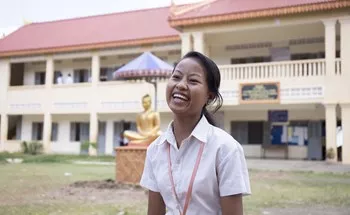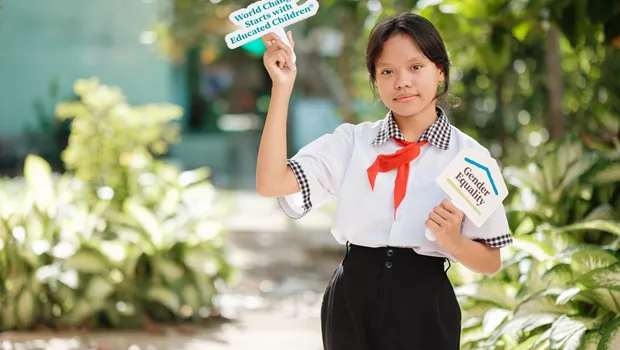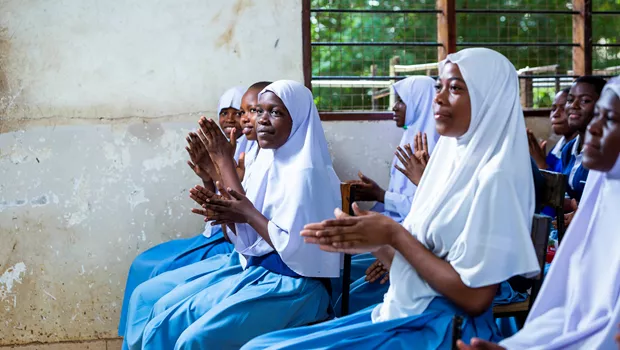
One Way Out of Poverty
Rim admits there are not many job options for her. Seab has tried to help her sister by earning income where she can.
“I’m not physically strong to work as a laborer,” said Seab. During the last semester break, she tried working at a cashew nut farmer for two weeks under the 95 degree heat (Fahrenheit). “It was very hot and airless on the farm. I earned USD0.125 by picking up a kilogram of cashew nuts. I picked up 90 kilograms per day.”
From dawn to dust, Seab made USD11.25 per day. At that point, she knew this was not the life she wanted and education was the only way out.
“I want to finish school, find a good job and support my sister back.”
A Change Maker
Seab’s love for school revolves around paying it forward. Working with other girls, Seab passes on what she’s learned in life skill classes to local children and adults – insight ranging from primary health care to the importance of education. With a dream to be a teacher, Seab enjoys the practice, but more importantly she wants to prove her villagers wrong.
The sun had just risen when 11th-grade Seab met her friend for their daily bike ride to high school. Raised in Cambodia’s rural Kampong Cham Province, the pair rides 8 kilometers through several villages and countless paddy-rice fields. Forty-five minutes later they reach school, but rarely are in the same condition they left in. Some days, their uniforms are soaked in sweat, on others they’re drenched by tropical rains. Yet, the ride is nothing compared to the arduous journey it took for Seab to get here.
Amongst the 30 Percent
“Only around 30 percent of people in my village have been to secondary school and not all complete it. All of them are from better off families than I am,” said Seab.
According to Cambodia’s Ministry of Education, Youth and Sport, only 56% of girls enroll in 7th grade and the number drops to 25% for upper secondary schools. People in Seab’s village believe that education is a luxury, something only meant for the rich who can afford it.
“I am the only one from a very poor family to study until grade 11, and I am very proud of that,” said Seab enthusiastically. She knows she can make it to graduation and she’s convinced her sister to believe it too.

A Sister Like No Other
Since losing her mother at the age of four, Seab lives with her oldest sister, Rim, who has done all she can to ensure Seab stays in school.
“There is no other person like her,” Seab said with watery eyes.
Rim has been both a mother and a father to her. Seab’s four siblings, left parentless, all started working on farms as children – a common fate in Cambodians, where 50% of girls are laborers instead of students. Rim, who only finished 2nd grade, can’t read or write.
“I am illiterate, and it’s very difficult. Even applying to work at the factories now, they still don’t want me. They want someone who can at least read and write. Even working at farms, it was difficult when I had to sign to get the money,” explained Rim.
Since her youth Rim has raised cows, chickens and babysat nieces and nephews while the rest continue to work as laborers on farms and factories. As the youngest, Seab is the only one to make it to 7th grade.
“Among us, she is the best student. I want her to study more in case she can find a better job than us,” said Rim.
Rim has sold five cows and many chickens to help fund Seab’s education. Yet, there aren’t always things to sell or extra funds for school.
“Sometimes when Rim couldn’t earn any money, she wanted me to stop studying, but I insisted. I told her that she has invested a lot so far. It would be a waste if I stop now.”

Journeying with Room to Read
In 2012, Seab enrolled in Room to Read’s Girls’ Education Program. Being from an incredibly poor family, Seab has received Material Support every year such as, uniforms, shoes and study materials. Without these basic items, many girls like Seab drop out unable to afford the essentials. Seab also received a bicycle in 7th and 10th grade, turning an approximate 90 minute, one-way walk into a 45-minute ride.
“I first learned about Room to Read when the village chief invited me to join an event at the school, where we received a bicycle and some studying materials. To some extent, it has helped us financially,” explained Rim. Since then she has participated regularly in various Room to Read events.
Beside Material Support, Seab also received mentoring, attended life skills classes, participated in study clubs and joined other educational campaigns.
“Now I am more confident and can teach others. I have to believe in my capacity, because otherwise I wouldn’t have the confidence to teach,” said Seab.
Sinath, Room to Read’s Social Mobilizer also commented on Seab’s rise in confidence and heightened ability to think more critically, seek help when needed and most importantly, explain the important of education to her sister.
Invest in children's education today.



